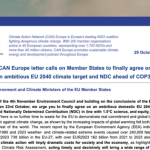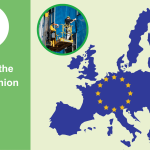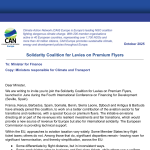PRESS RELEASE
Brussels, 15th December 2021 – The 2nd part of the ‘Fit for 55’ climate and energy package unveiled today by the European Commission doesn’t deliver on the pathway needed to reach the 1.5°C target and climate neutrality by 2040. Specifically, the set of legislative proposals related to gas reveal a tendency of giving fossil gas and hydrogen a prominent role instead of creating market rules that facilitate the decline of its use.
“At the core of the gas and methane legislation we would have expected to find clear signs towards the phase out of fossil gas by 2035 and towards a transition to a 100% renewable energy system that protects everyone against climate change, especially the most vulnerable. Instead, we have found ourselves with a disappointing Christmas tree decorated with inadequate and unsightly fossil gas baubles around which we refuse to sing carols,” said Esther Bollendorff, CAN Europe’s EU Gas Policy Coordinator.
The Commission’s announcement would have also been the opportunity to brighten up the Buildings Directive and reap all the multiple benefits linked to highly energy efficient, sustainable and fossil fuel-free buildings. “We see only timid steps forward, especially on the measures needed to trigger a real transformation such as mandatory energy performance standards. Now it is time for co-legislators to raise the bar on ambition to ensure that the vast energy saving and emission reduction potential of the building sector is not left untapped,“ said Edoardo Concari Coppola, CAN Europe’s Buildings Policy Coordinator.
The ‘Fit for 55’ and other EU measures must all point in the same direction and help go well beyond the climate target of at least 55% net greenhouse gas emission reduction towards at least 65% emission cuts in 2030.
“We foresee a busy 2022 trying to make the gas related pieces of legislation far more ambitious so that the EU contributes its fair share to the Paris Agreement. But the gaseous common thread goes far beyond these proposals. New rules under the taxonomy and revised State aid guidelines, are likely to give fossil gas a serious private and public funding boost. The Commission’s and member states’ resolution for the new year must be to stop fossil gas lock-in and to work towards more climate ambition and policy consistency,” added Bollendorff.
—ENDS—
‘FIT FOR 55’ SNAPSHOTS
Gas and Hydrogen package: Instead of shifting gas markets away from fossil fuels to direct electrification, heating and cooling from renewables as well as energy savings, the package promotes an untargeted use of hydrogen, stemming from fossil fuels or nuclear (so called low carbon hydrogen). Hydrogen is a scarce and expensive resource, it should be produced from renewables only and its use should be limited to certain priority sectors only. Unfortunately, this package is not up to the challenge as it does not come up with i) independent oversight for future hydrogen infrastructure planning, ii) ensure steep decline of fossil based gases and iii) prepare for the decommissioning of existing fossil gas infrastructure.
Methane Regulation: The new Commission’s methane regulation fails to include immediatly tangible measures to address methane leakages across the entire supply chain, limiting measures to methane emissions occurring only at gas facilities located within EU borders This is of crucial importance as more than 80% of the fossil gas consumed in the EU comes from imports and a significant amount of fossil gas life cycle methane emissions occurs at extraction wells and during its transport.
Buildings Directive: The proposal for the revision of the Energy Performance of Buildings Directive (EPBD) falls short of the level of ambition needed for the building sector. Despite improvements on key elements of the framework such as the national long-term planning, we see only timid steps forward with regards to measures aimed at increasing deep renovation of the existing building stock, notably minimum energy performance standards (MEPS). Provisions on new buildings finally exclude fossil fuel installations, but missed the opportunity to do it from 2025 as needed. Not to mention the persistent lack of policy attention to buildings’ whole life cycle and to the promotion of a more sustainable built environment. Now it is time for the co-legislators to raise the bar on ambition and ensure that the vast energy saving and emission reduction potential of the building sector is not left untapped.
ADDITIONAL SNAPSHOTS
TEN-E: Almost in parallel to the ‘Fit for 55’ launch, the European Council and the European Parliament came to an overnight agreement on rules for the Trans European Energy Infrastructure planning (TEN-E), which includes public funding for new fossil gas projects: EastMed and Melita. Thanks to the push made by shortsighted interests from a few countries including Cyprus and Malta, questionable exemptions will be granted to fossil gas projects whose total costs largely exceed the size of the available funds under CEF (Connecting Europe Facility).
State Aid CEEAG: The revised State aid guidelines for climate, energy and environmental aid (CEEAG) will most likely support fossil gas (and so called low carbon hydrogen) as a ‘transition fuel’ including infrastructure projects, LNG terminals, power plants and cogeneration plants. The revision of the Guidelines, which is expected to be adopted next week, is key as it will allow Member States to give public support to various energy carriers and technologies. It can be a powerful tool to complement the ‘Fit For 55’ if it gives incentives only for future proof solutions such as energy savings, flexibility and rapid deployment of renewables. However, the current proposal risks causing fossil gas lock-in over the next decades. Throughout the proposal, fossil gas is being treated more favourably than coal, oil shale and peat as they are defined as ‘most/more polluting fossil fuels’.
Taxonomy Delegated Act: The Commission is expected to label both gas and nuclear as “sustainable” investments in the EU taxonomy, most probably next week, after high pressure from lobby groups and some Member States. This would completely undermine the science-based nature of the EU taxonomy, which regulates private finance clean energy investments preventing greenwashing.
NOTE TO EDITORS
- Gas package. Policy briefing, NGO letter calling to rework the package.
- Methane. Blog post and Policy briefing.
- Buildings Directive. Buildings blog post, NGO letter, Policy briefing on the EPBD revision
- State Aid. CAN Europe’s response to State aid CEEAG public consultation and a joint NGO letter to the Commission
- Taxonomy. Letter to commissioner Timmermans
CONTACTS
Nina Tramullas, nina.tramullas@caneurope.org.
Rachel Brabbins, rachel.brabbins@caneurope.org.



